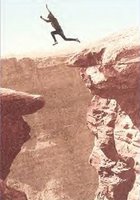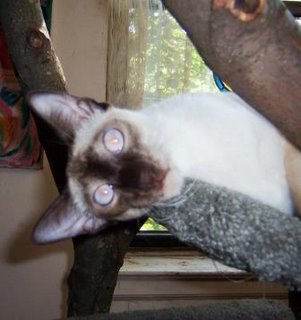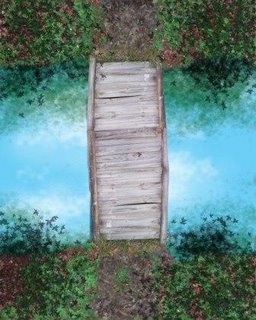 “If the doors of perception were cleansed, everything would appear as it is, infinite.”
“If the doors of perception were cleansed, everything would appear as it is, infinite.”
— William Blake
(1)“We have met the enemy and he is us.”— Pogo
(2)“Vast emptiness, nothing holy!”— Bodhidharma
(3)William Blake’s words speak of perception from the timeless and changeless point of conscious, Authentic Self awareness.
(4) They are paralleled by Pogo Possum’s earthy swamp wisdom, which hints about looking with honest humility to determine whether we’ve perceived a projection or a reflection, or are truly gazing through the gates of infinity. Bodhidharma exclaims at what is revealed beyond the gates of ego-mind.
There are, as Blake also suggested, vast differences in the world when seen through the eyes rather than with the eyes —
“To see a World in a Grain of Sand
And a Heaven in a Wild Flower,
Hold Infinity in the palm of your hand
And Eternity in an hour. . .
We are led to Believe a Lie
When we see not Thro' the Eye
Which was Born in a Night to Perish in a Night
When the Soul Slept in Beams of Light.
God Appears & God is Light
To those poor Souls who dwell in the Night,
But does a Human Form Display
To those who Dwell in Realms of day."(5)
The intention of this monograph is to stimulate the recognition and awakening of the feeling of one’s Authentic Self and one’s Original Source, and to begin readjustment of the simulate self’s processes. The material presented here is not meant to be theoretical or even academic, but as a guide to those who may have eyes to see and ears to hear."
(6) Neither is it meant to be a manual — the actual manual resides within the Authentic Self. The subject will be approached slowly and incrementally, and then repeated in different ways to carefully impress it upon the awakening mind of Authentic Self.
The simulate self is an obsessively opinionated, decision-making psychological component of our earthly mind-body. All thought arises from its mentality, which is the ego-mind. From what could be called the surface our inner space, this ego-mind outwardly projects our mind-body’s perceptions and its environment as well as the bodies and environments of others. The language of the simulate self is tribal and therefore judgmental and fear-based. It subscribes to judgmental concepts that use words and phrases such as “exclusive,” “better than/less than,” “best/worst,” “superior/inferior,” “evolved/degenerate,” “elite/common,” “special,” “restricted,” “chosen/damned,” “new and improved,” and “fashionable.” , complaint, and criticism are its food and drink. It is motivated by fame and recognition, and fueled by envy and competition. Insatiably seeking entertainment,
gleeful (7) and
gloating (8) best describe its sense of humor, which is delivered with jealousy, sarcasm, and resentment. The ego-mind loves competitive contests. It enjoys disasters, attracts them, and even manifests them.
The simulate self is future-oriented and cannot wait; it worries, and it worries about worry. Its language, which is couched in suggestions, generates anxiety and panic attacks. The ego-mind will seize upon the body’s minor aches and pains and escalate them into mental terrors and fantasies about disease and death.
Its preferred ways to begin a sentence are “I think–” and “I believe–.” It developed and ritualized the practice of “Say please” and “I told you so.” Co-conspiring ego-minds are responsible for politics, the economy, the destruction of the rain forests, art criticism, journalism, religion, and war, among many other things. The collective ego-mind’s greatest desire is to achieve a Global Madison Avenue. One of its most recent triumphs is called, ironically, “Reality TV.”
Few mind-embodied Authentic Selves are consciously aware of this psychological component of their mind-body-spirit, which some call the psyche or soul.
(9) This means that the vast majority of people are moving about in the world with the ego-mind in the driving seat while they sleep in the back, occasionally and briefly waking to look at the scenery passing them by, but then quickly falling back into hibernation. Its driving is compulsive, habitual, and irrational and its ever-increasing neuroticism is generally uncontrollable because of our ignorant somnambulance. As a species, we have relegated it to our underconscious, from where it secretly dictates most, if not all of our mental direction — or in other words, it completely controls our world.
(10)The ego-mind’s development began very soon after the dawning of human consciousness, and so the ego-mind is the original and most ancient source of human-generated deities. A slightly more detailed etiology of the simulate self will be presented further on.
Because of the unlimited energy constantly permitted it, the ego-mind is able to present and maintain the
semblance of a self-aware consciousness. In effect, this simulacrum or imitation manifests its own kind of form and simultaneously, a projected, perceived environment for this form. This environment arises from the multitude of anxious thoughts we allow the simulate self to generate and amplify, drawing from the vast expanses of energy circumscribed by our fear and trembling.
The label “false self” has been utilized by certain competitive factions of psychology, based mainly on psychoanalytical (neo-Freudian) and ego psychology models. The related terminology, such as ego strengths, transference, countertransference, neurosis, conscious, unconscious, super-conscious, and so on — which presume to be about treating the Authentic Self, are instead obliviously referring to
the ego-mind of the false self. Unless a therapist is consciously aware of her Authentic Self at some level, it’s more than likely that the therapy is an ongoing dialogue between two or more simulate selves. A therapist who is present in some way as Authentic Self is there to converse with the sleeping Authentic Self of the patient until some awakening dialogue begins to occur. The therapist also continues to awaken from conscious participation in the process. Often the patient literally falls asleep during these dialogues or lapses into some kind of shutdown of mental processes, such as short-term memory failure, or what could be called
psychospiritual amnesia. Therapists are not immune to this ego-mental stupor.
Metapsychological structure theory systems like ego psychology have receded into the background of contemporary therapies, and current interests are increasingly focusing on observation and immediate experience. Yet this kind of analytical language continues to be used in various areas of modern philosophical and spiritual thought — keeping in mind that
thought arises from the ego-mentality of the simulate self.
The word
false usually brings up the idea of something bad or unhealthy. This idea suggests that this “other self” is not only malevolent but that the assumed personality is inherently wicked or sick, and that the
person beneath the personality needs to be controlled, changed, healed, or eliminated. Because of the inferred relationship, there is usually an attack on one’s own or on another’s mind-body in some way.
(11) The ensuing violence is then directed — or self-directed — toward the sensed false self while actually impacting the pathologized real person.
To avoid strengthening established negative connotations, the false self is reintroduced here as the simulate self, which will also be called the ego-mind. The terms
simulate self,
ego-mind,
personality,
character, and
identity can all be exchanged for one another. They are the same in their illusory concepts, actions, and affects and effects.
Acknowledging the existence of the simulate self or the ego-mind begs the question, “What is the true or Authentic Self?” The ancient dictum “Know Thyself” is the open-ended answer, for while it can be acknowledged that the question has been raised, the answer can be revealed only as truth reveals itself through our individualized Authentic Self and its various states of awareness. These states of awareness are experientially known through vibratory sensation, which is
feeling. Krishnamurti maintained that “truth is a pathless land.” The core, Authentic Self will inevitably recognize the feeling of its truth in its various states, thereby recognizing Itself as an immortal being as It moves inwardly from any felt point, ever onward.
The simulate self fabricates, presents, and maintains a “personality” or “character” in order to appear real and to appeal to others. It has assigned the greatest importance to itself as our personality regarding the affairs of the world. It is extremely valuable to keep in mind that our personality is an illusion and not who we are at the core of our immortal existence. Our simulate self and the simulate selves of others will support one another’s personalities in order to keep the illusion of personality sustained. “Flattery will get you anywhere.” As a result, the ego-mind convinces us to make it our primary identity, and so whenever our ego is threatened we are influenced to believe that our Authentic Self is threatened. However, being immortal, our Authentic Self has nothing to fear.
It’s fairly easy to see the inherent negativity in a personality—especially when it’s someone else’s — as well as any resulting conflict when one feels threatened by another ego-mind presence, or even by its own ego-mind presence. It is a relentless suggestion of the simulate self that we let
it take the reins of our Authentic Self’s mind processes. Once we agree to this, it can then fulfill its agenda that everything would be easier and better if we just forget that it exists and let it continue on in its delusions while concealed in our underconsciousness. We are then permitted to continue on in our lives in complete unawareness of it. Most of us end up agreeing to this conspiracy with little or no questioning, much less with any conscious awareness of the situation or of having made any such agreement.
The simulate self could be said to makes its temporary home in our material body’s mental areas. The core, true self, or the Authentic Self, also dwells temporarily within the
non-mental areas of our interpenetrating material, etheric, and astral bodies. Although the simulate self’s ego-mind is always seeking to condition us, the primal, Authentic Self can never be conditioned. The Authentic Self does not think nor have thoughts, although it can observe them as they arise from the ego-mind, which is contained within the infinite space of Mind—which is also
imagination. As unaware beings whose lives are dictated by ego-generated beliefs, we allow the channeling of energy to sustain the reigning belief that the simulate self is the Authentic Self. We then give the simulate self the power to rule our body, our environment, and our life by its thinking and in any way it chooses.
The manifest world— “the ten thousand things” —is projected by the ego-mind.
(12) The manifest world— “the ten thousand things” —is projected by the ego-mind. A perceived projection is a
presumption of reality, giving rise within the mind of the ego to the illusions
it thinks we should experience as “the world.” The ego-mind will unfailingly and skillfully use the illusion of any form of presumed, perceived
loss — grief, fear, sadness, anger, regret, anxiety, and so on — to keep us from connecting with and awakening to true, present reality. Awareness of one’s immortal existence —one’s true presence — within an infinite universe of experience reveals that “loss” is only a thought, an idea with no base in reality whatsoever.
(13)Like all thought-ideas, the presumption of loss arises from lack of experiential awareness, which is misinterpreted as actual lack or “less-than” and even misconstrued as “more-than.” Lack of experiential awareness arises from fear and anxiety, which are generated by the ego-mind to keep the illusion of the presumed perceptions projected. Clearly this is a circular and repetitive cycle. This circumscription of the life experience also manifests an “edge,” beyond which is a
presumed “unknown” which serves as the threatening guard to keep us from exploring beyond the prison’s perimeters. (See Appendix 1 for a brief presentation about
the edge and about
waiting.)
The ego-mind detests change of any kind, for change signals transition, or at the very least, suggests the idea of death, and so it works continuously to use fear to keep the status quo. Yet change is how mutation comes about, and mutation is how a manifested universe allows us to move from one state of being to another, while simultaneously
being that experience, i.e., conscious, Authentic Self-awareness.
“True reality” does not mean
true in the sense of a straight line or a path unswervingly never altering. Rather, the
truth of Reality unceasingly emerges from the ever-mutating “ground” from which our manifested universe arises.
(14) The point of emergence is both dimensionless
and all-dimensional, depending on the amount of awareness in perception. In actuality, the point of emergence is one’s experience of being. Truth can appear to be contracting or expanding, like breathing; on or off, like a light bulb. While the reality of
Primal Creation does not contract and expand, blink on and off, or change — our awareness does change. As Reality, Creation is finished — it needs nothing more. Concerns and issues about “more than” or “less than” are therefore pointless.
Change, or mutation, is the vehicle for moving about and within Reality. Distance and space combine to manifest the sense of movement, simultaneously manifesting an experiential sense of time. Connecting with true Reality, or even the beginning awareness of a projected edge against Reality, would initiate a weakening of the simulate self’s structure, contributing to its possible dissolution and reintegration into something larger, even while the Authentic Self is still earth-embodied. The dissolution of the simulate self is inevitable, which it correctly understands and greatly dreads as its own kind of transition, or death. It also instinctively understands that it will eventually become severed from all its relationships with the material world when an individualized Authentic Self transitions to a state where a different kind of embodiment is experienced from the current one. The refusal to accept the instinctual knowledge of its own death and any related references to death is part of the complex ego-systems known as
denial.
Mutation is the means of continuance for material expression of our Authentic Self. For the simulate self mutation means an ending, or death. Where our Authentic Self is concerned, any ending contains the experience of the next beginning, and the next, and so on, forever. The construct known as the ego-mind has learned how to convince us that its sense of ending is our own. This feeling is not authored by Authentic Self and so is inauthentic to us, which we feel as a discomfort. This discomfort is little more than psychic effluvium, but because of our agreement to live by the rules of an inauthentic personality, we accept its idea that this feeling is something called “fear” and that we should act in a prescribed way when sensing it. Since our personality loves to own things in order to appear real, fear can be difficult to release. Using this fear like a gun at our heads, our ego-mind takes us hostage. It demands and is given so much
carte blanche energy that it could be said to have a mind of its own, the mind which used to be fully ours. This entity-like energy will do
anything to survive.
Although this entity-like energy is
not us, it is
like us, for it emulates our body’s own built-in biological drive for survival. Grief will be used as an example throughout this writing, since it embodies, literally and metaphorically, so many forms of assumed loss or of “less-than.” The deepest aspect of grief is sadness, which can underscore a human life for its entire earthly existence. For example, with grief as its weapon the simulate self may weaken us even to the point where the body will no longer sustain our spirit. There are people who have been said to have “died of a broken heart.” The ego-mind, like an enraged, spoiled child, can conduct a tantrum of such proportions that it will find a way to cause life energy for the body to be withheld, because somebody (some body) must be punished for the injustices inflicted upon it and upon the other body it believes it owns. The ego-mind is inherently suicidal. Homicide is seen as a justifiable against another simulate self, rather than as suicide, because the ego-mind cannot understand that all individuals are connected as one. In the case of bereavement, the injustice would be perceived as the loss of a loved one taken by “death.” It was the ego-mind that wrote and promotes all variations of the wedding vow, “til death do us part.” This give further insight to the ego-mind, which seeks control through an agreement called “a promise,” which is held to be “sacred” and “unbreakable.”
Even as our Authentic Self, we cannot help but miss our loved ones terribly and painfully. For most us this pain cannot be avoided and is part of living in this particular realm of manifestation. We have the ability to learn to accept that everyone “dies,” or more compassionately, “moves on.” But the ego-mind cannot deal with any reminder that it will eventually cease its own particular existence. The fear-sodden, enraged, non-sanity of the ego-mind becomes clearly obvious by its plan to survive even if it means destroying its host, our body, by proving that it is right in its beliefs, hence the illusion of its own superiority.
A Course in Miracles suggests the ego-mind would rather be right than happy.
(15) Actually, the ego-mind insists on having both.
(16)When our spirit-self withdraws from the terrestrial material body, the material is absorbed back into its source, the Earth, as well as by cosmic rays from the stars. Deprived of a material body, the ego-mind then has no further earthly function. Up to that point, supported by what could be called “cultural hypnosis,” the ego-mind believes that only the material world can fulfill its needs and desires. But since the material world is constantly changing, or re-manifesting, it can never fulfill the simulate self’s insistence on non-mutation. It refuses to accept any change over which it has no control and continues to search, to desire, to temporarily find, and then to lose what it found, in a never-ending cycle of games. Out of this cycle rises the addiction to material things, an automatic resistance to change, and, ultimately, fear of change. This addiction is not meant in the way one is attached to drugs or other forms of physical or emotional sensation. Rather, it is about the denial to understand that all materiality, as a reflection of one’s inner Self moving outward, is illusion — meaning that it’s temporary and impermanent. This denial must be explicitly maintained in order to achieve the illusory seamlessness needed to support the ego’s sense of self.
END OF PART 1.
______________________________
(1) William Blake,
The Marriage of Heaven and Hell, Oxford University Press, 1995.
(2) Walt Kelly, Pogo strip from Earth Day, 1971.
(3) Bodhidharma is credited with bringing Zen Buddhism to China and is the First Patriarch of Chinese Zen Lineage.
(4) Perceive is defined here as “to become aware of directly through any of the senses, especially sight or hearing.” The word’s origins are from the Indo-European kap–, “to grasp” which is at the deeper meaning of the word when further defined as “to achieve understanding of; to apprehend.”
(5) William Blake, “Auguries of Innocence.” Nicholson & Lee, eds. The
Oxford Book of English Mystical Verse, 1917.
(6) “God has given them a spirit of stupor, eyes that they should not see and ears that they should not hear . . .” (Romans 11:8).
(7) See ghel-
2 in Indo-European Roots.
(8) Middle English
gle, entertainment, from Old English
glēo. See ghel-
2 in Indo-European Roots
(9) Exploration of this component, called “the simulate self” here, has been presented in different metaphysical ways in other writings in the past two centuries, notably as “the kundabuffer” by Gurdjieff, “the physical mind/goldfish bowl” by Mirra Alfasa (also known as “Mother”) and recently as “the ego/false created self” by Eckhart Tolle.
(10) “Underconscious” is used here instead of the classic “unconscious.” “Un” implies something that doesn’t exist. Yet the realm of Self actually
is a realm of consciousness, and so Self is conscious in its own realm, whether or not it is
consciously aware of its own realm. Freud had posited the notion of the “preconscious” — where thoughts may temporarily reside between the “unconscious” and conscious awareness. Preconsciousness could be said to be where hunches and precognition wait for conscious awareness. Freud also believed that all memories rested in the preconscious, accessible at any time through various ways. However, memories are living things and as such do not rest anywhere, actively existing as “fields.”
(11)Our mind-body can be said to be “energy.” Our scientists have seen, albeit from a greatly limited perspective tempered by ego-mind perspectives, that all is energy, which cannot be destroyed but only manifested differently. This evidences that creation is finished and complete. “Manifesting differently” is experienced as change, and is
transition as well as
transformation. It is transformative transition, or
mutation.
(12) "The Tao that can be told is not the eternal Tao.
The name that can be named is not the eternal name.
The nameless is the beginning of heaven and Earth.
The named is the mother of the ten thousand things.”— Chapter One of
The Tao Te Ching, by Lao Tzu (trans. by Gia-fu Feng and Jane English, Vintage Books, 1989).
(13) Existence and experience are one and the same and can be interchanged here.
(14) The Self is the ground from which the feeling of “I AM” unceasingly emerges.
(15) A Course In Miracles, (Tiburon, CA: Foundation For Inner Peace, 1985), Text, 573.
(16) This perhaps not-so-obvious slip-up reveals the underbelly of
A Course In Miracles.
ACIM claims to have been “channeled by Jesus” to help earth-embodied people to deal with the ego-mind. It is suggested here that
ACIM is an impressive architecture of psychoanalytical virtuosity that was, in all probability, delivered by a non-embodied team organized and led by the crystallized ego-mentality of Sigmund Freud.
ACIM is not a hoax
per se; Everything in it is quite true if perceived and understood correctly, however it directs perception in such a way that it does exactly what it claims to undo, and
vice versa. Keeping in mind that fame and recognition is what the ego-mind requires, it must be noted that
ACIM has generated a large community of pseudo-scholarship — something ACIM's designers seem to have actually intended.
ACIM is a
game designed on a very high order, and although ultimately harmless, it takes a lot of time and energy from the experience of Authentic Self as an embodied entity on Earth.

 The Edge
The Edge
 The Authentic Self may also decide not to move or to jump off the cliff. Having reached an awareness of Its wings of immortality, fear no longer prevents or accompanies its choices. Whatever happens, there will be unlimited opportunity for Authentic Self to bring forth joy as a companion to the ever-present serenity of Original Source.
The Authentic Self may also decide not to move or to jump off the cliff. Having reached an awareness of Its wings of immortality, fear no longer prevents or accompanies its choices. Whatever happens, there will be unlimited opportunity for Authentic Self to bring forth joy as a companion to the ever-present serenity of Original Source.



